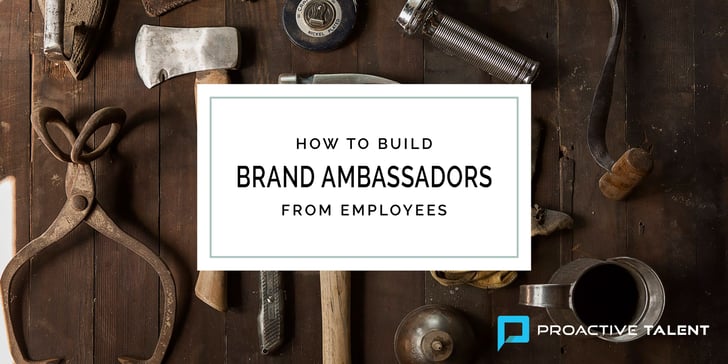
Building a brand ambassador program can be a powerful tool you should already be utilizing to help improve your Employer Brand. If you don’t have one yet, the best approach on how to start an employee brand ambassador program is to create brand ambassadors out of engaged employees at your company who are already sharing their work experience either internally or externally. In order to do this, employee engagement is critical, not only to build brand ambassadors, but also to increase the future success of your company. I have found that if you boost your employee engagement, all your other company metrics improve. At the end of the day, effective employer branding is really the byproduct of strong employee engagement practices.
Once you have active brand ambassadors, you will be able to attract more like-minded candidates that are aligned with your company’s mission and therefore want to work for your company. Here are a few things to keep in mind when beginning to build your employees as brand ambassadors.
Start with Defining Your Metrics
To successfully build brand ambassadors out of your employees, first define your success metrics. These success metrics are different for every company. To identify your company’s own, think about what success looks like for your employer brand. This could range from brand awareness, increased content engagement, or employee engagement and retainment. You can measure yourself against these goals by first measuring your baseline, where you are now). This could mean tracking metrics such as your current retention rate, company careers- related hashtag usage, employee engagement on channels like Twitter, LinkedIn, etc. and analytics on current content such as reach, impressions, likes, and comments. Before you start your program, you must be able to identify what success means to your organization and create clear metrics to test out what you’re looking to gain.
Before you begin your program, I always recommend conducting a culture and engagement survey for your employees. This provides you with a good baseline and makes measuring success in the future much easier. The survey will allow you to see how engaged your employees are with your brand now and compare changes down the road.
Delivering the Message
Once you can define your brand ambassador program, the next step is to communicate that to your employees.
Practice the 30/70 rule
While the messaging is extremely important, you must be able to effectively deliver the message. I always recommend the 30/70 rule: 30% message and 70% messenger. In order to drive a successful initiative, the communication needs to be from the top down and bottom up. Your culture and employer brand should be a part of the language at your company – how people are talking. This language is adopted by your employees when it is spoken by people in power and leadership. When employees see actions back up the words they are hearing, that’s when change will happen. Leaders - from executives to middle management - need to “walk the talk” and reward employees who are living out the company values.
Identifying existing advocates
Target employees who are already actively sharing on social media about your company’s values and referring employees. Recruit the people who are excited and sharing internally, and have them help you share externally, as well.
Don’t begin your program with a mass rollout
Building these kinds of programs doesn’t come naturally to some company cultures, particularly the ones that aren’t good at “tooting their own horn.” So, test it out first. Start with employee-led groups such as Employee Resource Groups (ERGs). Test your success with specific metrics and repeat until you receive optimal results. Then, slowly and organically grow it over time. Rome wasn’t built in a day and strong employer brands are the same way - they take years to build. It is very important to not assume your employees will be onboard. Educate your employees and then bring them along the journey with you.
Technical Solutions
Keep it simple
Fancy tech and platforms alone won’t get your employees more active for your brand. Keep your technology simple in the beginning and grow it as the program grows. Start with basic employee advocacy tools that focus on distribution. Hootsuite, Buffer, Feedly for content curation, VideoMyJob for self-service mobile video creation, and ICIMS for crowdsourced employee content, are a few good options that still keep employees in the driver seat. Distribution strategy can be sticky, but these tools can save time while also helping build your employees’ personal brands as well. When you have current employees doing the talking for you, it’s much more impactful than any other approach. At the end of the day, potential candidates are 3x more likely to trust employees over recruiters, or even the CEO!
“Needs” versus “Wants”
Depending on budget constraints, you may not even be able to use a tool right from the start. In that case, you could begin by using Google Sheets and a simple dashboard like these to track employee engagement and notify stakeholders.
No matter which one you decide on, it’s important to keep in mind these four basic elements that are necessary for any advocacy tool:
- It organizes your content
- It distributes content to key stakeholders
- It notifies stakeholders when there is fresh content
- It measures performance (hashtags are a great way to do this!)
Incentives
To get maximum participation, you’re going to have to pay for your employees’ love. But it doesn’t all have to be about the money. Here are four incentive strategies that aren’t strictly monetary:
- Swag like a branded shirt, water bottle, backpack – something genuinely useful
- Learning & Development (i.e. special one-on-one lunch with CEO)
- Health & Wellness
- Employee Recognition (i.e. personalized, limited edition t-shirts)
Sharing is Caring
Focus on the experience
Create unique experiences along the employee journey, because it’s the best way to get employees to share stories about the culture and what life is like at your company. Shared personal experiences from your employees are the most impactful for your brand ambassador program.
Don't assume everyone at your company knows exactly what to do when it comes to sharing your company’s story. Set up simple and fun training sessions for your employees who aren’t social- –media -savvy.
Make it easy
Make it as easy as possible for your employees to share their experiences as brand ambassadors. Create an employer brand toolkit and provide templated ways of sharing your messaging. Alternatively, let employees opt-in for different services that let them choose when, where, and what content gets posted to their social media pages.
I recently did a webinar with RecruitingDaily on this very topic. You can watch the full video here:


